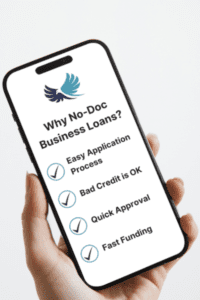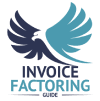
A no-doc loan for small business needs can work much better than a traditional bank loan in many situations. However, not all business lenders offer them, and they work differently than other loan products you may be accustomed to.
On this page, you’ll learn how no-doc loans work, how they’re different from other business financing options, and ways to secure a no-doc loan for your small business.
The Appeal of a No-Doc Loan for Small Business
The phrase “no-doc” is short for “no-documents.” It means the lender doesn’t require the borrower to supply many of the financial statements that traditional loans require. Very few options fit this definition exactly, and most of them are in the consumer market rather than business. For instance, a short-term loan or payday loan fits in this bracket. These types of no-doc loans are often provided by online lenders that link to your bank account and use sophisticated algorithms to determine how much to lend to you.
In the business market, you’re more likely to find “nearly no-doc” or reduced documentation lenders. They’ll still likely require business bank statements and possibly other proof to show that you can repay your loan, but the threshold is still considerably lower than traditional lenders expect. Because this increases risk for lenders, they’re more likely to require collateral or a personal guarantee on the loan, though, as you’ll see when we cover no-doc loan options, that’s not always the case.
To create a clearer picture of how no-doc business loans work for small businesses, let’s quickly compare them to traditional loans.
Traditional Bank Loan Requirements Are Rigid and the Process is Slow
Financial institutions like banks and credit unions have a lot of requirements when you try to secure a traditional business loan. In terms of documents, you’re usually expected to submit the following:
- Business licenses and permits
- Articles of incorporation
- Franchise agreements
- Lease agreements
- Up to a year of business bank statements
- Business and personal tax returns going three years back
- Projected balance sheets
- Income statement
- Cash flow statement
- Schedule of business debts
- List of current accounts receivable
- And sometimes more
Your lender will evaluate all these documents and other details, such as your credit score and time in business, then determine if you qualify and your loan terms. Because it’s a labor-intensive process and there’s legal red tape, it can take weeks or months for approval to come through. After approval, it may take up to a couple of weeks to see payment.
Why Opt for Invoice Factoring Over Traditional Bank Loans for Small Business Financing
For small business owners navigating financial challenges, invoice factoring presents a compelling alternative to traditional bank loans, including various no-doc business loan options. Unlike conventional loans, which often require extensive documentation and can take weeks to process, invoice factoring converts outstanding invoices into immediate liquidity. This method excels in situations where rapid access to capital is crucial, without the stringent credit requirements and collateral often necessary for traditional loans. Factoring companies focus on the creditworthiness of your invoices rather than your personal credit score, making it an accessible solution even for businesses with less-than-perfect credit histories.
Invoice factoring bypasses the lengthy and often restrictive approval processes associated with traditional bank loans, significantly enhancing a company’s ability to manage cash flow and reinvest swiftly into business operations. This streamlined financial solution not only addresses immediate cash needs but also supports sustainable business growth—traits highly valued by small business owners seeking efficient and effective financing solutions. Additionally, unlike no-doc loans that might still demand some form of verification and often carry higher interest rates, invoice factoring provides a straightforward, debt-free approach to financing. By leveraging your receivables, you can ensure continuous capital flow without accumulating debt, which is essential for maintaining and expanding business operations in competitive markets.
With invoice factoring, small businesses can also avoid the pitfalls of other financing types such as lines of credit or merchant cash advances, which may complicate cash flow management due to their variable terms and conditions. Factoring offers a clear, predictable path to financial stability, making it an ideal choice for businesses that need to maintain steady growth without the usual financial hurdles posed by traditional lending and no-doc loans. This makes invoice factoring not just a practical choice but a strategic one for small businesses aiming to thrive in today’s dynamic business landscape.
No-Doc Business Loans Work Differently Than Traditional Bank Loans
While each type of financing differs, no-doc loans for small businesses usually have shorter repayment terms than traditional options, and you’ll likely need to provide a personal guarantee or collateral. In return, you won’t have to supply the same documentation and will benefit in many other ways.
No-Doc Loans Offer Unique Benefits
- Easier Application Process: No-doc means less paperwork to dig up and supply.
- Bad Credit is Usually Ok: Lenders are less concerned about your credit history, months in business, and other details that banks typically scrutinize.
- Quicker Approval: Your application will typically be processed within a week. A few high-tech lenders also offer same-day or next-day approvals.
- Faster Access to Capital: No-doc loans typically pay out within a few days. Some lenders offer same-day payments.
5 No-Doc Loan Options for Small Businesses
Now that we’ve covered the background, let’s look at some of the most common no-doc financing options, and how they work so it’s easy to identify the best solution for your current business needs.
1. Business Credit Cards
Business credit cards work similarly to consumer credit cards in that you’ll be given a credit limit from which you can draw, and you’ll pay it back in monthly payments that include interest and sometimes fees.
A typical business credit card limit is a little over $50,000, according to Nasdaq. This means cards are typically better for minor expenses, such as purchasing office supplies and perhaps smaller equipment like computers.
Those with good credit will pay an annual percentage rate (APR) of around 17 percent. If your credit isn’t strong, rates can climb to 30 percent or more. Some credit card companies also require collateral.
The challenge with credit cards is that the debt can really pile up, and many businesses only pay the minimum required each month rather than paying off the entire balance. That means you may wind up paying two or three times more for an item than what was charged at the time of sale.
2. Business Lines of Credit
A line of credit (LOC) works like a credit card. However, a $100,000 limit is typical, and some lenders allow businesses to withdraw up to $250,000, per Bank of America. That means you can use a LOC for much larger purchases, to cover payroll, or in place of an equipment loan.
The APR on business lines is generally slightly lower than a card, but the risks are similar. For this reason, it’s better to pay off your balance in full each month.
You may be able to qualify for a LOC based on your credit score and proof of revenue, but it’s more likely that a no-doc lender will require some form of collateral.
3. Merchant Cash Advances
If your business accepts credit cards, you may be able to obtain a merchant cash advance from your provider. Loan amounts vary widely and are primarily determined by the amount of cash you bring in through credit card processing.
If you qualify, your merchant card processor may offer you a lump sum payment or treat your loan like a line of credit. Rather than paying your balance back in installments, though, your processor will hold back a percentage of your transactions each day.
This can be beneficial because it eliminates worry about keeping up with payments. However, it also means you won’t know exactly how much you will pay on any given day. This can make managing cash flow and planning other expenditures more difficult.
MCAs don’t use APRs to calculate your borrowing costs. They use something called a factor rate, which is usually between 1.2 and 1.5. You slide the decimal over two spots and multiply it as a percent by your advance to determine how much. For instance, if you borrow $50,000 and have a factor rate of 1.5, you’ll pay $75,000 back. If you’re expected to pay your MCA back within six months, this actually works out to an APR of more than 180 percent. In other words, it gets the job done, and your merchant card processor likely has all the documentation they need from you, but it will be one of the most expensive ways to borrow for most businesses.
4. Crowdfunding
Crowdfunding is more diverse than most people realize. That’s because, by its definition, it simply references many people coming together to provide your funding instead of just one entity. Your backers, investors, or lenders aren’t generally institutional lenders with crowdfunding. They’re typically everyday people who participate for different reasons. Because of this, there’s often less financial scrutiny, but the people involved may be looking for other things from you. Below, we’ll quickly review a few types of crowdfunding and how they work.
Rewards-Based Crowdfunding
Rewards-based crowdfunding is likely the first model that comes to mind for most people. The model is often used in place of a startup business loan or to fund a new product launch. People participate to receive something of value, such as the product you’re selling or related merchandise. They don’t receive any equity in your company or get their money back. Because of this, you must be able to generate significant hype about your cause. You’re more likely to get funded if your brand story is engaging or your product is novel.
Donation-Based Crowdfunding
The donation-based model works similarly to the rewards-based model in that participants don’t receive equity in the company and are not repaid. However, it differs because they don’t receive anything in return for supporting you. People are only likely to donate if they feel a personal tie to your organization or if you can evoke emotion, and you’ll need to campaign heavily to reach your goal. The donation-based model tends to work better for nonprofits or businesses with close ties to their communities and a pressing need. For instance, if you operate a local shop and a storm damages your business, or you want to upgrade your facilities to include a community space, you might have luck with this model.
Peer-to-Peer Lending
Often shortened to P2P, peer-to-peer lending works more like a traditional loan but one that’s funded by lots of people. Your investors expect to receive their money back with interest. While it can be a no-doc solution, your investors will likely want to see your business plan and other evidence that they’ll receive payment in full.
Equity Crowdfunding
Equity crowdfunding is similar to P2P lending, but instead of receiving repayment with interest, your investors receive a stake in your business. Because of this, investors are usually looking for startups with the potential for rapid growth.
5. Invoice Factoring
Invoice factoring sets itself apart because it’s more of a debt-free cash flow accelerant. Instead of waiting weeks or months for your B2B customers to pay their invoices, you’ll sell your unpaid invoices at a discount to a third party known as a factor or factoring company. You’ll receive most of an invoice’s value within a couple of days. Some companies offer expedited processing, such as same-day funding or payment on the next business day. When your customer pays their invoice, you receive the remaining balance minus a small factoring fee.
Factoring companies don’t take equity in your company or charge interest. Instead, they use a factor rate to calculate your costs. This is usually between one and five percent of the invoice’s value.
Because your client is ultimately responsible for paying the balance, their creditworthiness is more of a concern than yours. This means you often have no minimum credit score requirement, and most businesses qualify.
Factoring companies are known for offering flexible terms. You can factor the invoices of your choosing as you need to accelerate cash flow. This also means it can be leveraged in many different ways. For instance, many businesses use it as they scale to cover materials or increased overhead. Others use it when they have a lull in business or slow-paying customers and need to cover crucial expenses like payroll.
Get a Free Factoring Rate Quote
If factoring sounds like the ideal funding solution for your business, we’re happy to match you with a factoring company that aligns with your needs and offers competitive rates. To learn more or get started, request a complimentary factoring rate quote.

About Invoice Factoring Guide
Related Articles
Get an instant funding estimate
Results are estimates based on the calculated rate and the total invoice amount provided.
Actual rates may vary.
Request a Factoring Rate Quote
PREFER TO TALK? Call us at 1-844-887-0300










